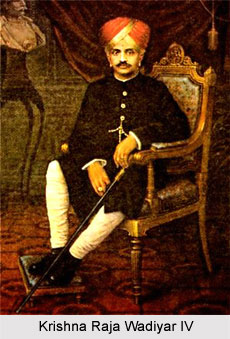 Krishna Raja Wadiyar IV, also known as Nalwadi Krishna Raja Wadiyar, was the Maharaja of the princely state of Mysore. He ascended the throne from the year 1902 and ruled over his territory until 1940, when he died. Krishna Raja Wadiyar IV is considered amongst the most renowned Indian prince, when the country was still under British dominion. At the time of his death, the Maharaja was one of the wealthiest people in the world. Krishna Raja was also a philosopher and was addressed as Rajarshi, meaning saintly king, by Mahatma Gandhi. He was the twenty fourth ruler of the Wadiyar or Wodeyar dynasty of Mysore. The dynasty ruled of the state of Mysore from 1399 to 1950.
Krishna Raja Wadiyar IV, also known as Nalwadi Krishna Raja Wadiyar, was the Maharaja of the princely state of Mysore. He ascended the throne from the year 1902 and ruled over his territory until 1940, when he died. Krishna Raja Wadiyar IV is considered amongst the most renowned Indian prince, when the country was still under British dominion. At the time of his death, the Maharaja was one of the wealthiest people in the world. Krishna Raja was also a philosopher and was addressed as Rajarshi, meaning saintly king, by Mahatma Gandhi. He was the twenty fourth ruler of the Wadiyar or Wodeyar dynasty of Mysore. The dynasty ruled of the state of Mysore from 1399 to 1950.
Early Life of Krishna Raja Wadiyar IV
Krishna Raja Wadiyar IV was born on 4th June 1884 at the Royal Palace, Mysore, to the parents Maharaja Chamaraja Wadiyar IX and Maharani Vani Vilas Sannidhana. He was their eldest son. His father died in the year 1894 in Calcutta (now Kolkata) when he was still a minor. Thus his mother ruled the state as Regent until he came of age. The much respected Indian prince was initially educated under P. Raghavendra Rao at the Lokaranjan Palace. Krishna Raja was well learned in Sanskrit and Kannada, apart from Western studies. He was also taught Indian and western Classical music and horse riding. Sir Stuart Fraser of the Bombay Civil Service trained him in administrative operations.
Krishna Raja Wadiyar IV as a Ruler
Krishna Raja Wadiyar IV ascended the throne in the year 1895 as a minor. He received complete ruling powers as the Maharaja of Mysore, from Viceroy Lord Curzon on 8th August 1902, at a ceremony at Jagan Mohan Palace. He transformed the princely state of Mysore into one of the most developing and progressive states in the country during that era. The state advanced in many areas like agriculture, industry, art and education. Most of the development work in educational infrastructure that was undertaken during that time was done with objective of forming Karnataka as the foremost technology hub in India in the 20th century.
 Krishna Raja Wadiyar IV was the initial chancellor of University of Mysore and Banaras Hindu University. He also worked towards the improvement of the Indian Institute of Science at Bangalore (now Bengaluru). During his rule, the Maharaja enlarged the Representative Assembly in Mysore which became bicameral with the formation of the Legislative Council in the year in 1907. During his rule, the princely state of Mysore became the first state in India to generate hydroelectric power in Asia. Further more Mysore was the first city in entire Asia to have street lights, which were started on 5th August 1905.
Krishna Raja Wadiyar IV was the initial chancellor of University of Mysore and Banaras Hindu University. He also worked towards the improvement of the Indian Institute of Science at Bangalore (now Bengaluru). During his rule, the Maharaja enlarged the Representative Assembly in Mysore which became bicameral with the formation of the Legislative Council in the year in 1907. During his rule, the princely state of Mysore became the first state in India to generate hydroelectric power in Asia. Further more Mysore was the first city in entire Asia to have street lights, which were started on 5th August 1905.
Krishna Raja was a patron of Hindustani and Carnatic music and also Western classical music as well. He greatly worked to alleviate poverty and improve the state of education, economic regeneration and fine arts in the region. The Maharaja was an accomplished musician and patronised the advancement of the fine arts. His reign is regared as the Golden age of Mysore.
Personal Life of Krishna Raja Wadiyar IV
Krishna Raja Wadiyar IV got married to H.H. Maharani Lakshmivilasa Sannidhana Sri Pratapa Kumari Ammani Avaru on 6th June 1900.
Titles of Krishna Raja Wadiyar IV
Maharaja Krishna Raja Wadiyar IV held several titles through out his reign such as-
* Yuvaraja Sri Krishnaraja Wodeyar Bahadur, Yuvaraja of Mysore (1884-1894)
* His Highness Maharaja Sri Nalwadi Krishnaraja Wodeyar IV Bahadur, Maharaja of Mysore (1894-1907)
* His Highness Maharaja Sri Sir Nalwadi Krishnaraja Wodeyar IV Bahadur, Maharaja of Mysore, GCSI (1907-1910)
* Colonel His Highness Maharaja Sri Sir Nalwadi Krishnaraja Wodeyar IV Bahadur, Maharaja of Mysore, GCSI (1910-1917)
* Colonel His Highness Maharaja Sri Sir Nalwadi Krishnaraja Wodeyar IV Bahadur, Maharaja of Mysore, GCSI, GBE (1917-1940)
Honours of Krishna Raja Wadiyar IV
Krishna Raja Wadiyar IV was honoured several times. These include-
* Delhi Durbar Gold Medal (1903)
* Knight Grand Commander of the Order of the Star of India (1907)
* Bailiff Grand Cross of the Order of St John (1911)
* Knight Grand Cross of the Order of the British Empire (1917)
* King George V Silver Jubilee Medal (1935)
* King George VI Coronation Medal (1937)






































